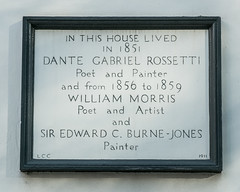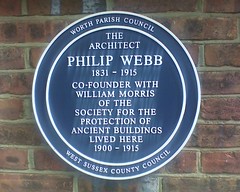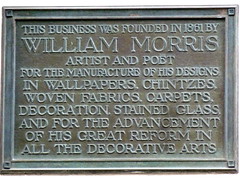William Morris
Commemorated on 10 plaques
In this house lived in 1851 Dante Gabriel Rossetti (1828-1882), poet and painter, and from 1856-1859 William Morris (1834-1896), poet and artist, and Sir Edward Burne-Jones (1833-1898), painter.
17 Red Lion Square, London, United Kingdom where they lived
Red House built in 1859-60 by Philip Webb architect for William Morris poet and artist who lived here 1860-1865
Red House Lane, Bexleyheath, London, United Kingdom where they lived
The architect Philip Webb 1831 - 1915 co-founder with William Morris of the society for the protection of ancient buildings lived here 1900-1915
Turners Hill Road, Pound Hill, Crawley, United Kingdom where they was
Robert Spence Watson (1837 - 1911) Bensham Grove was home to Robert Spence Watson who enjoyed a national prominence in both artistic and political circles. His visitors included William Morris and Dante Gabriel Rossetti. A noted arbitrator in industrial disputes, pacifist and Liberal politician.
Bensham Grove, Bensham Road, Gateshead, United Kingdom where they visited
91-101 Worship Street Built as workshops and dwellings Designed by Philip Webb, 1862 Friend and colleague of William Morris. Co-founders of the Society for the Protection of Ancient Buildings, 1877.
91-101 Worship Street, London, United Kingdom where they was
This business was founded in 1861 by William Morris Artist and Poet for the manufacture of his designs in wallpapers, chintzes, woven fabrics, carpets, decoration, stained glass, and for the advancement of his great reform in all the decorative arts
17 St George Street, W1, London, United Kingdom where they was
Directly opposite stood Elm House (demolished in 1898 ) in extensive grounds, the birthplace of William Morris 24 March 1834
Fire Station, 341/343 Forest Road E17, London, United Kingdom where they was born near (1834)
William Morris 1834-1896 lived here 1848-1856. Edward Lloyd Publisher lived here 1857-1885
William Morris Gallery, Forest Road E17, London, United Kingdom where they lived (1848-1856)
William Morris lived at Woodford Hall 1840-1847. The house demolished in 1900 stood to the rear of this site
Woodford Parish Church Memorial Hall, High Street, E11, London, United Kingdom where they lived (1839-1846)
Site of the William Morris Printworks Here stood the Merton Abbey works of William Morris, established in 1881 in buildings used for calico printing since 1752. Morris and his co-workers produced carpets, tapestries, printed fabrics, and stained glass made to designs and patterns which were typical of the best of the "Arts and Crafts Movement", many of which remain famous today. The works continued after Morris's death in 1896, finally closing in 1940.
Merton Abbey Mills, Merton, London, United Kingdom where they produced carpets, tapestries, printed fabrics, and stained glass made to designs and patterns which were typical of the best of the Arts and Crafts Movement (1881)






.jpg?width=250)

_in_extensive_grounds_the_birthplace_of_William_Morris_24_March_1834.jpg?width=250)


